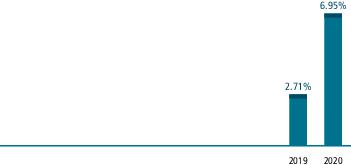Form 497K GOLDMAN SACHS TRUST
Summary
Prospectus
April 30, 2021
Goldman Sachs Managed Futures Strategy Fund
Class
P: GMQPX
Before you invest, you may want to review the Goldman Sachs
Managed Futures Strategy Fund (the “Fund”) Prospectus, which contains more information about the Fund and its risks. You can find the Fund’s Prospectus, reports to shareholders and other information about the Fund online at www.gsamfunds.com/mutualfunds. You can also get this information at no cost by calling 800-621-2550 for Institutional, Service and Class R6 shareholders, 800-526-7384 for all other shareholders or by
sending an e-mail request to [email protected]. The Fund’s Prospectus and Statement of Additional Information (“SAI”), both dated April 30, 2021, are incorporated by reference into this Summary Prospectus.
Annual Fund Operating Expenses
(expenses that you pay each year as a
percentage of the value of your investment)
| Class P | |
| Management Fees | 1.00% |
| Other Expenses | 0.22% |
| Acquired Fund Fees and Expenses | 0.23% |
| Total Annual Fund Operating Expenses1 | 1.45% |
| Fee Waiver and Expense Limitation2 | (0.23)% |
| Total Annual Fund Operating Expenses After Fee Waiver and Expense Limitation | 1.22% |
| 1 | The “Total Annual Fund Operating Expenses” do not correlate to the ratios of net and total expenses to average net assets provided in the Financial Highlights, which reflect the operating expenses of the Fund and do not include “Acquired Fund Fees and Expenses.” |
| 2 | The Investment Adviser has agreed to: (i) waive a portion of its management fee payable by the Fund in an amount equal to any management fees it earns as an investment adviser to the affiliated funds in which the Fund invests; (ii) waive a portion of its management fee in an amount equal to the management fee paid to the Investment Adviser by the MFS Subsidiary (as defined below) at an annual rate of 0.42% of the MFS Subsidiary’s average daily net assets; and (iii) reduce or limit “Other Expenses” (excluding acquired fund fees and expenses, transfer agency fees and expenses, service fees, taxes, interest, brokerage fees, expenses of shareholder meetings, litigation and indemnification, and extraordinary expenses) to 0.254% of the Fund’s average daily net assets. The management fee waiver arrangement with respect to the MFS Subsidiary may not be discontinued by the Investment Adviser as long as its contract with the MFS Subsidiary is in place. The other management fee waiver and expense limitation arrangements will remain in effect through at least April 30, 2022, and prior to such date the Investment Adviser may not terminate the arrangements without the approval of the Board of Trustees. |

2 Summary
Prospectus — Goldman Sachs Managed Futures Strategy Fund
3 Summary
Prospectus — Goldman Sachs Managed Futures Strategy Fund
4 Summary
Prospectus — Goldman Sachs Managed Futures Strategy Fund
5 Summary
Prospectus — Goldman Sachs Managed Futures Strategy Fund
| AVERAGE ANNUAL TOTAL RETURN |
| For the period ended December 31, 2020 | 1 Year | Since
Inception |
| Class P Shares (Inception 4/17/2018) | ||
| Returns Before Taxes | 6.95% | 2.57% |
| Returns After Taxes on Distributions | 6.64% | 1.44% |
| Returns After Taxes on Distributions and Sale of Fund Shares | 4.32% | 1.54% |
| ICE BofAML USD LIBOR One-Month Constant Maturity Index (reflects no deduction for fees or expenses) | 0.66% | 1.66% |
After-tax
returns are calculated using the historical highest individual federal marginal income tax rates and do not reflect the impact of state and local taxes. Actual after-tax returns depend on an investor’s tax situation and may differ from those
shown. In addition, the after-tax returns shown are not relevant to investors who hold Fund Shares through tax-deferred arrangements such as 401(k) plans or individual retirement accounts.
6 Summary
Prospectus — Goldman Sachs Managed Futures Strategy Fund
[This page intentionally left blank]
7 Summary
Prospectus — Goldman Sachs Managed Futures Strategy Fund
[This page intentionally left blank]
8 Summary
Prospectus — Goldman Sachs Managed Futures Strategy Fund
SELSATSUM4-21P
Serious News for Serious Traders! Try StreetInsider.com Premium Free!
You May Also Be Interested In
- Goldman Sachs Upgrades The TJX Companies (TJX) to Buy, 'best-in-class operator'
- Rubrik Announces Pricing of Upsized Initial Public Offering
- Stabilization Notice
Create E-mail Alert Related Categories
SEC FilingsRelated Entities
Goldman SachsSign up for StreetInsider Free!
Receive full access to all new and archived articles, unlimited portfolio tracking, e-mail alerts, custom newswires and RSS feeds - and more!



 Tweet
Tweet Share
Share
